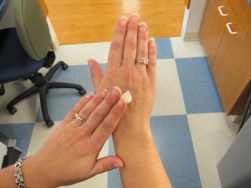Winter is coming! As if cold weather and runny noses aren’t bad enough, winter brings dry, cracked and itchy skin. It’s only November and my hands have aged 40 years! This is a problem that I see with kids every year, and not just the kids with eczema. Therefore, this is a perfect time to brush up on your skin care regimen for everyone in the house. First, let’s start with the basics.
Your skin
The top layer of skin is called the epidermis. This is your waterproof barrier that keeps moisture in and offenders out. When the weather gets cold and dry, more water evaporates from the skin and the epidermis dries out. That loss of humidity in the atmosphere makes it harder for your skin to hold moisture in. Furthermore, frequent hand washing causes a lost of moisturizing oils from the skin. Once the skin is dry and crack it can increase your risk of inflammation and infection in the skin.
What are the symptoms?
If you are experiencing dry skin, most likely your skin feels rough and scaly and may be itchy. Sometimes the skin will dry out so much that it may crack or bleed. For some people, the skin will also get red. The hands and lower legs are the most common place to see these symptoms but the dry skin can happen anywhere. Frequently the lips get chapped which causes many kids to lick their lips. This becomes a vicious cycle as the licking makes it worse (the salt in the saliva draws water out of the skin).
Treatment options
The goal of treating dry skin is to get the moisture back in while limiting the amount of moisture that is taken away. Below is a list of steps that can help relieve dry skin all through the winter.
- Avoid hot showers
- Limit showers or baths to 10-15 minutes only
- Wash with a mild fragrance-free soap
- Pat dry your skin and leave it a little damp, the apply a thick fragrance-free moisturizer over the wet skin to lock in moisture
- Avoid alcohol based sanitizer as much as possible
- Drink lots of fluids
- Use a humidifier in the home
- Apply petroleum jelly to chapped lips
- Avoid lip licking
The thicker the moisturizer, the better it will be at holding in moisture. That means ointments like Vaseline or Aquaphor are a good first choice. Next best is the thick creams that come in a tub like Eucerin, CeraVe or Cetaphil. Finally, there are thinner lotions available that are easier to apply but don’t always hold in as much moisture. Some lotions have urea or lactic acid which can be really helpful for excessively dry skin but they can also sting when applied.
My recommendations are by no means an exhaustive list of available products and I’m sure there are products out there that work really well that I have not mentioned. I am not paid to recommend these products, they are simply common and easy to find and I know they work. Many people love to use coconut oil and it has become very popular. If that works well for you, stick with it. It does not hold in moisture as well as the mineral oil based products so if you are not getting relief from coconut oil, it is time to switch.
Medication
Topical medication may be indicated if the dry skin leads to dermatitis, or inflammation of the skin. If the skin is red and itchy, a topical corticosteroid like hydrocortisone can be used twice daily to relieve symptoms. However, don’t use topical steroids for more than 2 weeks to minimize the risk of side effects. If you think your child needs topical medication, visit your pediatrician.
Hopefully with some good routines everyone in your family will maintain soft skin all winter long!



